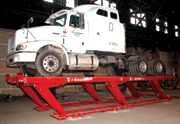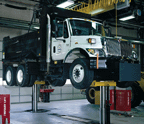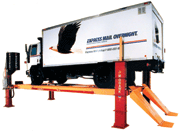Productivity in truck fleet maintenance operations is affected by many factors, including equipment choices, shop design and layout. In particular, the proper selection of lifts can have a significant impact.

Reputable industry lift manufacturers belong to the Automotive Lift Institute (ALI), the trade association of North American manufacturers of in-ground lifts as well as marketers of overseas lift systems. In cooperation with the National Bureau of Standards, ALI sponsors current national standards covering lift safety requirements for construction, testing and validation.
ALI member companies market lifts that bear the “gold label” of the ANSI-accredited ALI automotive lift certified lift program.
Correct choice
“The correct choice of lift can be a determining factor in shop productivity and efficiency,” says Steve Perlstein, sales and marketing manager at Mohawk Lifts. “Things to consider include size, space and traffic flow. Ask yourself the right questions, such as the type of work you are doing and what you are lifting.”
The four primary lift types used to service Class 8 vehicles offer several advantages and disadvantages, according to Perlstein. For example, in-ground lifts use the least amount of floor space and create fewer obstructions, which can help boost productivity. On the other hand, they require a dedicated bay and can be expensive to install, especially when the necessary concrete work is considered. Furthermore, in-ground lifts are virtually permanent and therefore not easy to move if shop needs or traffic flow changes.
Flush- and surface-mounted parallelogram lifts, according to Perlstein, can enhance shop productivity because they offer the ability to drive the vehicle on and raise it without having to reposition the lift. They also use less bay space than other designs and are more flexible, as they can handle varying wheelbases. Flush-mount models, however, require concrete work to become permanently installed.
In general, drive-on style lifts such as four-post designs are most popular for Class 8 vehicle maintenance operations, he says.
“These lifts offer a fast means of raising the vehicle, are favorably priced and allow technicians to work upright in a well-lighted, safe environment,” Perlstein says. “Four-post lifts can be equipped with options like jacks to raise the wheels for brake service, and there are 60-ft long models with six posts for servicing 53-ft trailers. Their only real downside is that they are a bit wider than parallelogram lifts because the posts that support the ramp are outside the vehicle.”
Mobile column lifts are great for flexibility because they can be moved to adjoining bays as needed, a plus in smaller shops, according to Perlstein. This flexibility of changing the location where a vehicle is raised – even outdoors if needed – is offset only by the time it takes to move and reposition the mobile column.

Accurate layout
Regardless of the number or types of lifts in a shop facility, proper placement and an accurate layout is important to maximize efficiency, says Scott Bair, heavy-duty product manager at Rotary Lift. For example, in the design of a facility, lifts should be positioned to optimize technician productivity, facilitate smooth traffic flow and make the best use of the space available. This can be accomplished by analyzing vehicles and traffic patterns, as well as where lifts should be placed in reference to walls and toolboxes.
To assist in this effort, Rotary offers a facility planning service for fleets, dealers and independent repair shops. Called AssistPRO, the service includes detailed analysis of vehicle turning radii and traffic flow for the type of equipment being serviced, Bair says. It also provides custom layouts to help place lifts in positions that promote maximum productivity. Final drawings are offered as Adobe PDF documents, color prints or AutoCAD drawings that can be imported into architectural design software.
Bair also points out the advantages of specific lift types for heavy-duty vehicle maintenance operations. Four-post lifts, for instance, are an affordable and easy-to-use option that can generate productivity improvements. These lifts can be used to service a wide range of vehicles, including commercial trucks, up to and including Class 8 models.
With four-post designs, vehicles are properly set on the lifts quickly by simply driving on and raising the vehicle. These lifts also are available with options, such as rolling jacks to provide access to brakes, suspension systems and wheels, and can be fitted with drive-through ramps. Other options include air lines, turning radius gauges, oil-drain pans and turntable cutouts for alignment service.
Pit lifts, which have been used in Europe for a long time and are now available in the United States, are touted by Rotary as capable of enhancing productivity in commercial truck service facilities that use pits to perform maintenance.

“Pit lifts can enhance shop productivity by enabling access to most components by allowing vehicles to be raised above ground level in a single bay,” Bair says. “With the addition of a pit lift, inspection bays can be used for just about any maintenance and repair task, including undercarriage, brake and tire work, and technicians can safely inspect and repair vehicles in one place for greater productivity.”
Pit lifts are offered in floor-running and suspended designs. Floor-running pit lifts are available as free-moving models with caster wheels or rail-mounted for use where pit floors are cracked or uneven. Suspended pit lifts ride on rails at the top of the pit. In both cases, adapters enable technicians to use pit lifts as component service or removal tools.
“Using vehicle lifts for repair and maintenance generally increases shop productivity,” Bair states. “Make the best lift selections for growing service needs now and in the future because a properly equipped shop is a more productive environment.”
